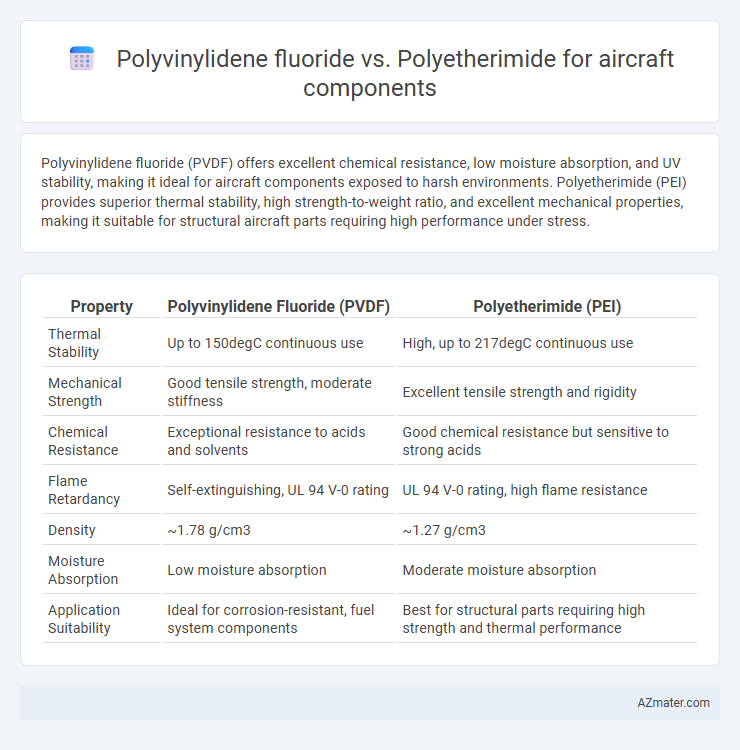Polyvinylidene fluoride (PVDF) offers excellent chemical resistance, low moisture absorption, and UV stability, making it ideal for aircraft components exposed to harsh environments. Polyetherimide (PEI) provides superior thermal stability, high strength-to-weight ratio, and excellent mechanical properties, making it suitable for structural aircraft parts requiring high performance under stress.
Table of Comparison
| Property | Polyvinylidene Fluoride (PVDF) | Polyetherimide (PEI) |
|---|---|---|
| Thermal Stability | Up to 150degC continuous use | High, up to 217degC continuous use |
| Mechanical Strength | Good tensile strength, moderate stiffness | Excellent tensile strength and rigidity |
| Chemical Resistance | Exceptional resistance to acids and solvents | Good chemical resistance but sensitive to strong acids |
| Flame Retardancy | Self-extinguishing, UL 94 V-0 rating | UL 94 V-0 rating, high flame resistance |
| Density | ~1.78 g/cm3 | ~1.27 g/cm3 |
| Moisture Absorption | Low moisture absorption | Moderate moisture absorption |
| Application Suitability | Ideal for corrosion-resistant, fuel system components | Best for structural parts requiring high strength and thermal performance |
Introduction to Polyvinylidene Fluoride (PVDF) and Polyetherimide (PEI)
Polyvinylidene fluoride (PVDF) is a high-performance fluoropolymer known for its exceptional chemical resistance, UV stability, and excellent mechanical properties, making it ideal for aircraft components exposed to harsh environmental conditions. Polyetherimide (PEI) is a high-temperature thermoplastic with outstanding strength, rigidity, and dimensional stability, widely used in aerospace for structural parts requiring flame retardancy and resistance to hydrocarbon fuels. Both materials offer unique advantages in aircraft manufacturing, with PVDF excelling in corrosion resistance and PEI providing superior thermal and mechanical performance.
Key Material Properties: PVDF vs. PEI
Polyvinylidene fluoride (PVDF) offers excellent chemical resistance, UV stability, and high dielectric strength, making it ideal for aircraft components exposed to harsh environmental conditions and electrical insulation needs. Polyetherimide (PEI) provides superior mechanical strength, high thermal stability up to 217degC, and exceptional flame retardancy, which is critical for structural and safety-critical aircraft parts. The choice between PVDF and PEI depends on the balance between chemical durability and mechanical/thermal performance in demanding aerospace applications.
Mechanical Strength Comparison for Aircraft Applications
Polyvinylidene fluoride (PVDF) offers excellent chemical resistance and moderate mechanical strength, making it suitable for non-structural aircraft components requiring durability and impact resistance. Polyetherimide (PEI) exhibits superior mechanical strength, high thermal stability, and excellent dimensional stability, ideal for structural aircraft parts exposed to high stress and temperature variations. For aircraft applications demanding critical load-bearing capacity, PEI outperforms PVDF due to its higher tensile strength and rigidity.
Thermal Stability in Aerospace Environments
Polyvinylidene fluoride (PVDF) and Polyetherimide (PEI) exhibit distinct thermal stability profiles crucial for aircraft components operating in aerospace environments. PVDF offers excellent chemical resistance and maintains performance up to approximately 150degC, making it suitable for moderately high-temperature applications. In contrast, PEI demonstrates superior thermal stability with a continuous use temperature around 170-200degC, making it ideal for critical components exposed to higher thermal stress in aerospace settings.
Chemical Resistance: Performance in Aviation Conditions
Polyvinylidene fluoride (PVDF) exhibits exceptional chemical resistance against fuels, lubricants, and hydraulic fluids, making it suitable for aircraft components exposed to harsh chemical environments. Polyetherimide (PEI) offers good chemical resistance but tends to degrade faster than PVDF when exposed to aggressive aviation chemicals and solvents. PVDF's superior resistance to UV radiation and oxidation ensures longer durability and reliability in demanding aviation conditions.
Weight and Density Considerations
Polyvinylidene fluoride (PVDF) has a density of approximately 1.78 g/cm3, making it lighter compared to Polyetherimide (PEI), which has a density around 1.27 g/cm3, allowing for significant weight savings in aircraft components. The lower density of PEI contributes to an optimized weight-to-strength ratio, essential for reducing overall aircraft mass and improving fuel efficiency. When selecting materials for aircraft components, balancing PVDF's chemical resistance with PEI's higher mechanical strength and lower density is critical for weight-sensitive applications.
Processing and Manufacturability for Aircraft Components
Polyvinylidene fluoride (PVDF) offers excellent chemical resistance and ease of processing through melt extrusion and injection molding, making it suitable for complex aircraft components requiring tight tolerances. Polyetherimide (PEI), known for its high thermal stability and dimensional accuracy, is typically processed via injection molding and thermoforming, enabling the manufacture of lightweight, high-strength aircraft parts. While PVDF provides superior chemical resistance and good processability, PEI excels in mechanical performance and heat resistance, influencing material selection based on specific aircraft component requirements.
Cost Analysis: PVDF versus PEI in Aviation
Polyvinylidene fluoride (PVDF) offers lower raw material costs compared to Polyetherimide (PEI), making it a cost-effective option for non-structural aircraft components where chemical resistance and durability are essential. PEI, while more expensive, provides superior thermal stability and mechanical strength, justifying its higher upfront investment for critical engine and structural parts exposed to extreme conditions. Life-cycle cost analysis favors PVDF for applications requiring corrosion resistance with moderate performance demands, whereas PEI's price premium aligns with long-term savings through enhanced performance and reduced maintenance in high-stress aviation environments.
Regulatory Compliance and Certifications
Polyvinylidene fluoride (PVDF) and Polyetherimide (PEI) are both used in aircraft components due to their compliance with stringent aerospace standards such as FAA and EASA regulations. PVDF meets certification requirements for chemical resistance and flame retardancy under FAR 25.853, making it suitable for interior cabin parts. PEI is certified under UL 94 V-0 flame classification and conforms to AMS 3195, offering superior mechanical strength and thermal stability for structural components.
Conclusion: Selecting the Optimal Polymer for Aircraft Components
Polyvinylidene fluoride (PVDF) offers exceptional chemical resistance, UV stability, and excellent dielectric properties, making it suitable for aircraft components exposed to harsh environments. Polyetherimide (PEI) provides superior mechanical strength, thermal stability up to 217degC, and flame retardancy essential for structural and high-temperature applications. Choosing between PVDF and PEI depends on specific aircraft component requirements, balancing environmental exposure with mechanical and thermal performance needs.

Infographic: Polyvinylidene fluoride vs Polyetherimide for Aircraft component
 azmater.com
azmater.com